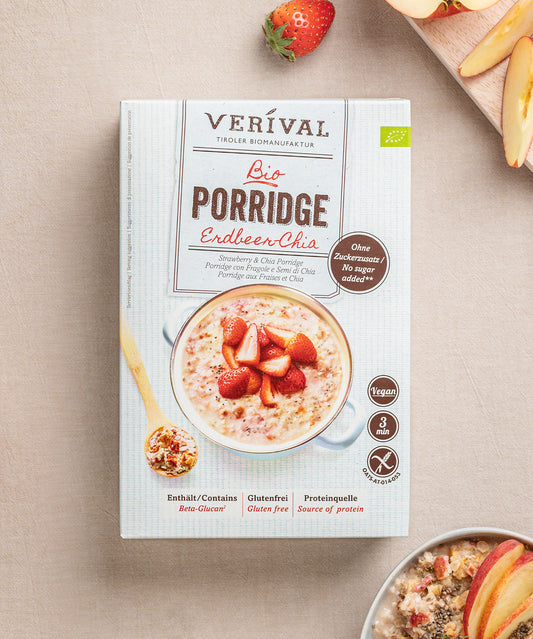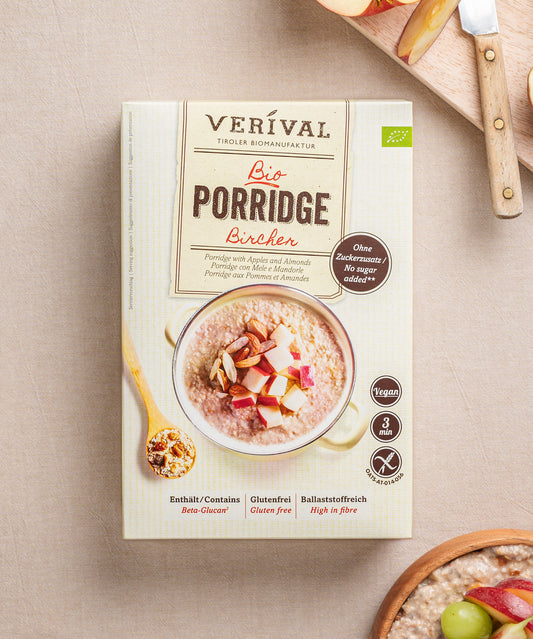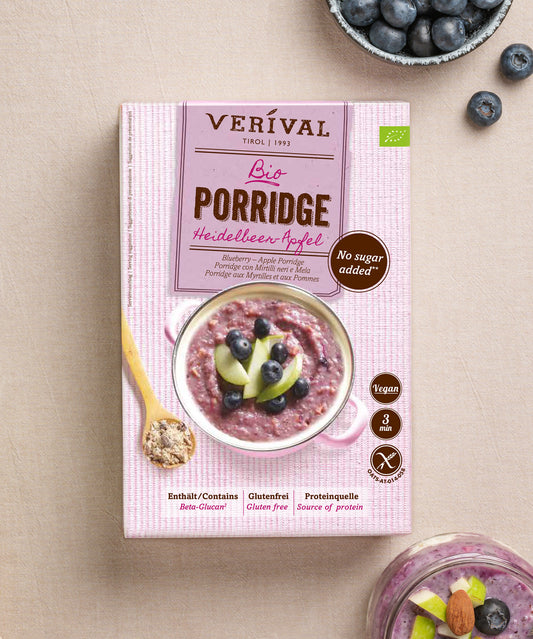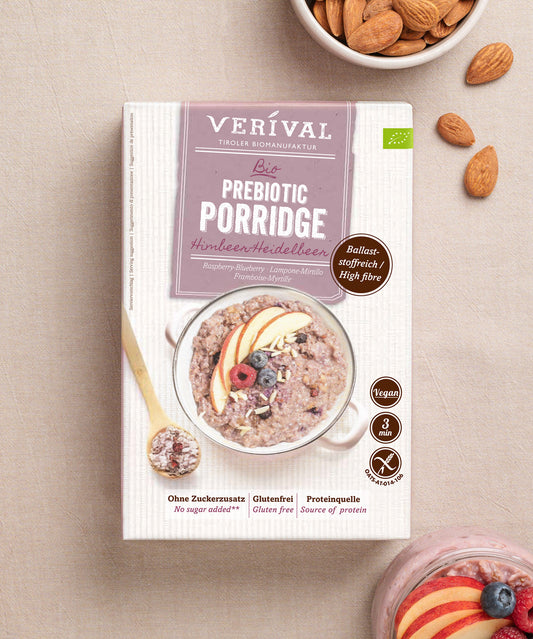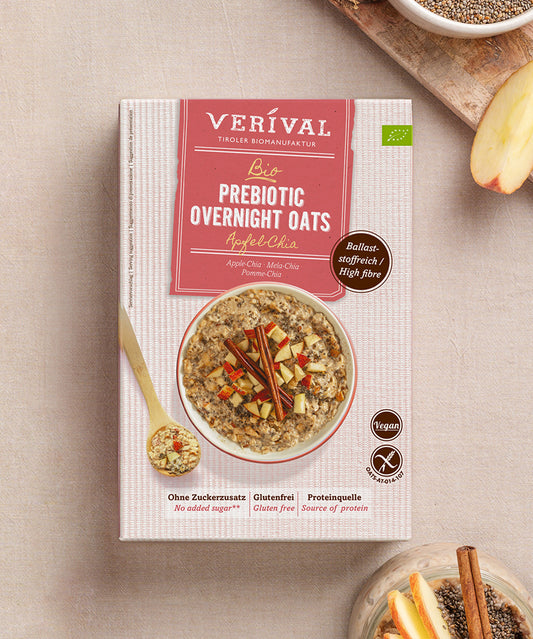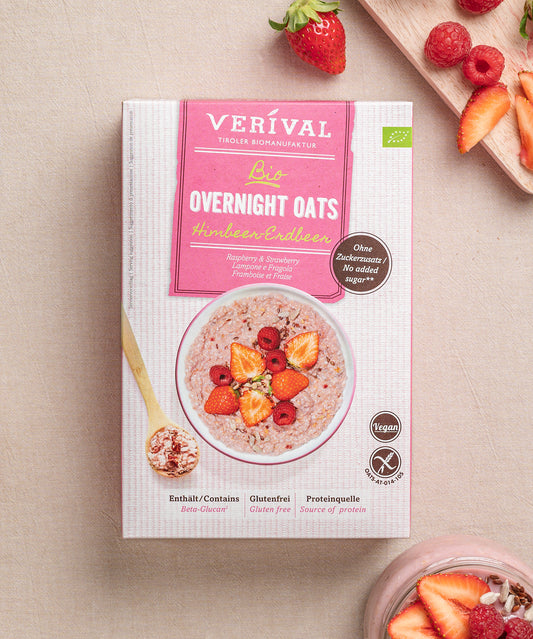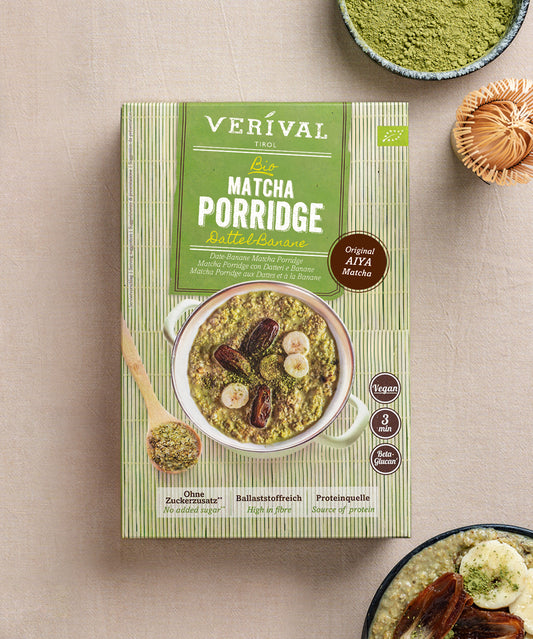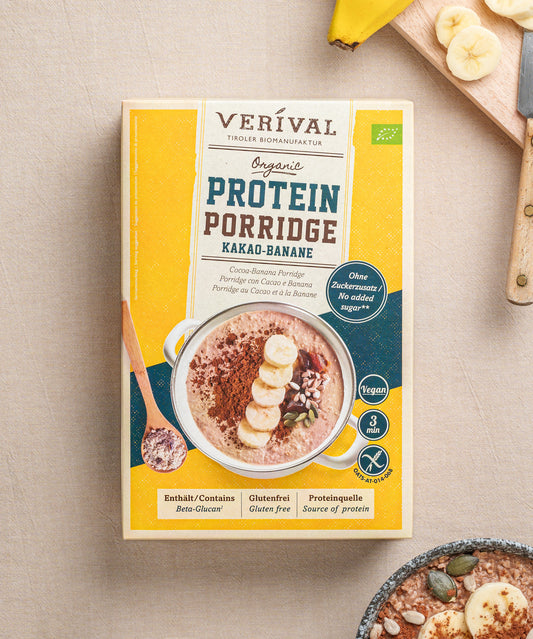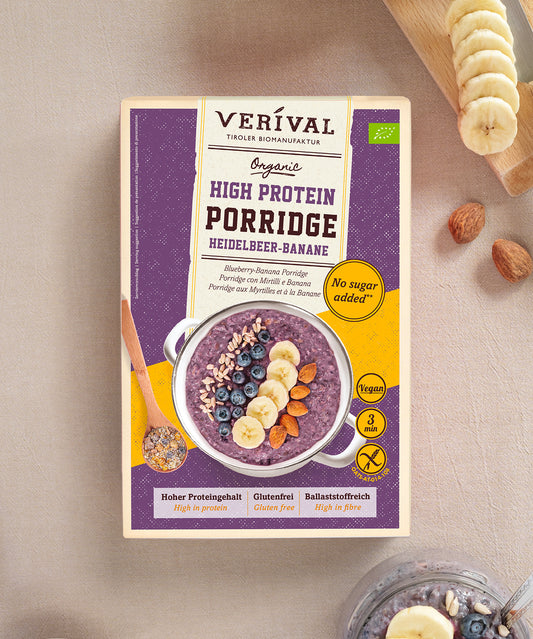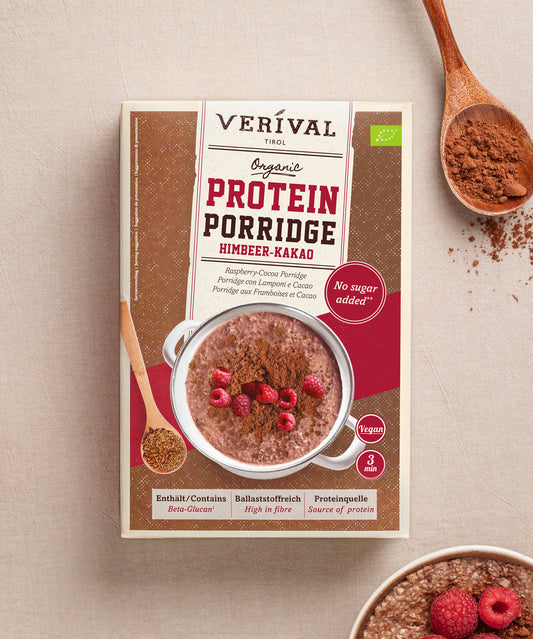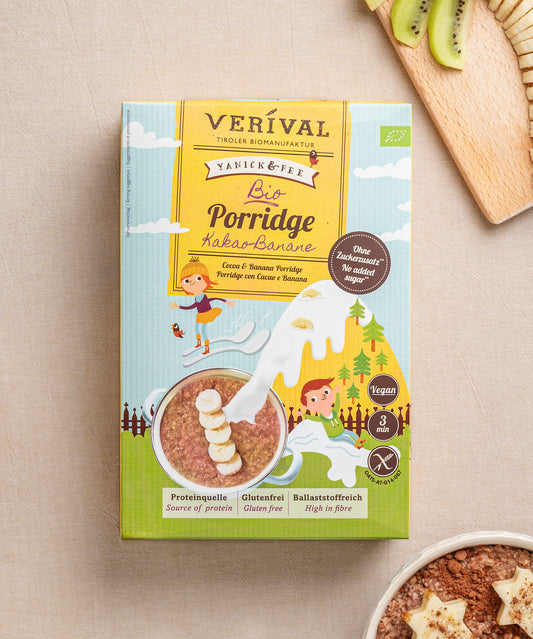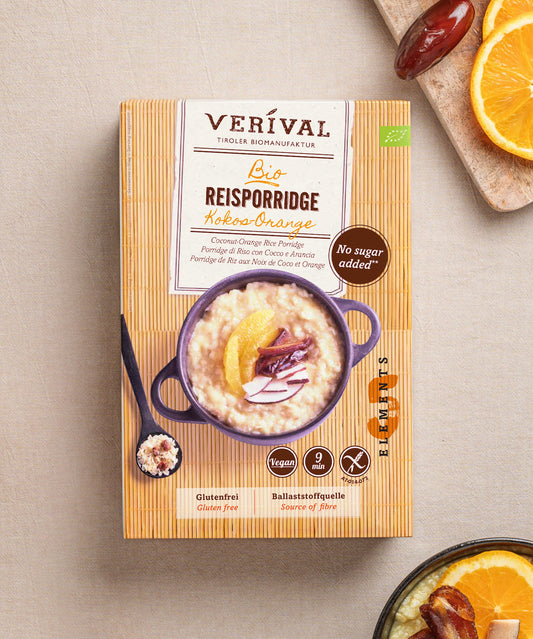Imagine enjoying a glass of red wine or a piece of mature cheese and shortly afterwards being plagued by headaches, skin redness or stomach problems. For many people, this is reality – they suffer from histamine intolerance. This intolerance to the body's own messenger substance histamine can cause a wide range of symptoms and significantly impair quality of life. In this article, you will learn what histamine intolerance is, what causes it, what symptoms it has, and how you can alleviate your symptoms through targeted nutrition and lifestyle changes.
Verival breakfast without added sugar – try it now
What is histamine intolerance?
Histamine intolerance is not a classic allergy, but rather an intolerance to histamine – a biogenic amine that is found in many foods and is also produced in the body itself. In those affected, the breakdown of histamine is impaired, leading to a buildup in the body and various symptoms.
Role of diamine oxidase (DAO)
The enzyme diamine oxidase (DAO) is primarily responsible for breaking down histamine in the body. It is mainly produced in the intestinal mucosa. If DAO activity is reduced – whether due to genetic factors, diseases or certain medications – histamine cannot be broken down sufficiently, leading to intolerance.
Frequency and diagnosis
The exact prevalence of histamine intolerance is difficult to determine because the symptoms are nonspecific and often resemble other conditions. It is estimated that about 1% of the population is affected. The diagnosis is usually made through a combination of medical history, elimination diet, and, if necessary, laboratory tests.
What does histamine actually do in the body?
Histamine plays a central role in the body. It acts as a neurotransmitter in the central nervous system, regulates the sleep-wake cycle, influences stomach acid production, and is involved in immune responses.
Histamine in immune responses
In allergic reactions, histamine is released from mast cells, leading to symptoms such as itching, swelling, and redness.
These reactions are part of the body's natural defense mechanisms.
Intake through food
In addition to being produced by the body, histamine is also absorbed through food. Fermented, matured, or spoiled foods in particular contain high amounts of histamine. If DAO activity is impaired, this additional intake can lead to an overload.
What can trigger histamine intolerance?
Some people have genetically lower DAO activity. Mutations in the DAO gene can impair enzyme production or function, which increases the risk of histamine intolerance.
Diseases of the gastrointestinal tract
Diseases such as Crohn's disease, celiac disease, or irritable bowel syndrome can damage the intestinal mucosa and thus impair DAO production. An imbalance in the intestinal flora (dysbiosis) can also have a negative effect on histamine utilization.
Hormonal influences
Hormonal fluctuations, such as during the menstrual cycle, pregnancy, or when taking oral contraceptives, can influence DAO activity and thus alter histamine tolerance.
Stress and lifestyle
Chronic stress can increase the release of histamine and reduce DAO activity. An unhealthy lifestyle with little exercise, irregular meals, and lack of sleep can worsen symptoms.
Knowing and recognizing the symptoms of histamine intolerance
The symptoms of histamine intolerance are varied and affect different organ systems:
- Skin: redness, itching, hives
- Gastrointestinal tract: flatulence, abdominal pain, diarrhea, nausea
- Cardiovascular system: rapid heartbeat, low blood pressure, dizziness
- Respiratory tract: stuffy or runny nose, difficulty breathing
- Central nervous system: headaches, migraines, sleep disturbances
Individual reactions
The severity of symptoms varies greatly among those affected. Some react to even small amounts of histamine, while others tolerate larger amounts. The combination of different foods containing histamine can also influence symptoms.
Keep a symptom diary
A detailed symptom diary can help you identify links between foods and symptoms. Write down what you eat, when you eat it, and what symptoms occur. This will help you identify and avoid potential triggers.
How histamine intolerance is treated
Histamine intolerance cannot be definitively diagnosed with a single laboratory test – it remains a so-called exclusion diagnosis.
This means that you start with an elimination diet, avoiding all foods that contain or release histamine for 2–4 weeks. During this time, you closely monitor your symptoms. If they disappear or improve significantly, histamine intolerance is likely. You then reintroduce foods one at a time, step by step. This allows you to determine your personal tolerance levels.
A food diary is invaluable during this phase. It not only helps you identify triggers, but also helps you structure your daily routine and regain control.
DAO supplements – helpful, but not a substitute
There are over-the-counter supplements containing the enzyme diamine oxidase that you can take shortly before meals high in histamine. These supplements can support the acute breakdown of histamine in the gut – for example, when eating out or attending a dinner party. However, they are not a long-term solution. You should only use DAO tablets as a supplement, not as a license to eat whatever you want. Furthermore, they only work on histamine from food – not on the histamine produced by the body.
Long-term strategy: diet & lifestyle
The goal of treatment is not a life full of restrictions, but a better sense of well-being. Over time, you will find out which foods you tolerate well, in what quantities, and under what circumstances. With a little practice, many people develop a very keen sense of their bodies and organize their daily lives accordingly—without restricting themselves too much.
Histamine intolerance: Foods you should avoid
People who suffer from histamine intolerance often notice very quickly which foods trigger symptoms – but not always immediately and not always clearly. This is because it is not only the histamine content of an individual food that counts, but also combinations, storage time, processing, and how your body is feeling on a given day. Nevertheless, there are certain foods that cause problems in almost all cases and that you should avoid altogether or at least in reduced quantities.
Why some foods are particularly problematic
Histamine accumulates in foods, especially if they have been ripened for a long time, fermented, heavily processed, or not refrigerated properly. During these processes, histamine is produced by microorganisms. The content therefore increases over time, and this is precisely what makes many popular products real histamine bombs.
In addition, there are so-called “histamine liberators.” These foods contain little histamine themselves, but cause mast cells in the body to release histamine, which can lead to the same symptoms. There are also DAO inhibitors: foods that block the activity of the enzyme diamine oxidase and thus slow down its breakdown.
Foods you should avoid or reduce
Foods that are particularly high in histamine include:
- Mature cheeses such as Parmesan, Camembert, Gouda, Emmental
- Smoked, cured or fermented meat (e.g. salami, ham, bacon)
- Canned fish, smoked salmon, canned tuna
- Sauerkraut, soy sauce, miso, tempeh
- Alcohol – especially red wine, sparkling wine, and beer
- Ripe tomatoes, eggplant, spinach, avocados
- Processed foods with additives, preservatives, or yeast extracts
Some plant-based foods are also considered histamine liberators or DAO inhibitors, including:
- Citrus fruits (oranges, lemons, grapefruit)
- Strawberries, bananas, kiwis
- Nuts, especially walnuts and cashews
- Cocoa, chocolate
- Black tea, green tea, and energy drinks
It's all about the amount and combination
The good news is that many people with histamine intolerance can tolerate small amounts of certain foods, especially when they are fresh and not eaten in combination with other sources of histamine. The total amount consumed is often the deciding factor. It is therefore advisable to not only look at individual foods, but to keep an eye on your overall intake throughout the day. Two histamine-rich meals in one day is often too much, even if you can tolerate them individually.
Mast cell-friendly and low-histamine cooking – what is it?
If you suffer from histamine intolerance, it is often not enough to simply avoid foods that are high in histamine. The way you cook, how fresh your ingredients are, and how you store your food also have a significant impact on how much histamine ends up on your plate – and how well you tolerate your food.
What does “mast cell-friendly” mean?
Mast cells are specialized immune cells that store histamine and release it when needed—for example, during allergic reactions, infections, or even stress. In people with histamine intolerance, these cells are particularly sensitive. The goal of a mast cell-friendly diet is therefore to avoid anything that unnecessarily irritates these cells or triggers histamine release.
This includes not only avoiding highly processed or added substances, but also being mindful of how you prepare and store food.
What you should always keep in mind in the kitchen
A low-histamine diet is not just about “avoiding” certain foods, but also about being mindful. Proper storage, preparation methods, and your sense of freshness make all the difference. With a little practice, you will quickly develop a good eye for foods that you can tolerate—and you will be able to cook creatively without feeling restricted.
5 tips for histamine intolerance
Being diagnosed with histamine intolerance is often a relief – finally, there is an explanation for years of discomfort. At the same time, it presents new challenges. How do I cope with everyday life? How do I organize my diet? What can I do if I am invited out on short notice? With these five practical tips, you can master living with histamine intolerance step by step – without stress and without constantly worrying about what you eat.
1. Find your individual tolerance level
Every person with histamine intolerance reacts differently – and to different foods. While you may not be able to tolerate tomatoes at all, you may be able to eat small amounts of avocado or citrus fruits without any problems. It is important that you take your personal reactions seriously and do not let others impose a blanket list of restrictions on you. It is best to write down what you eat, how you feel, and what symptoms occur for several weeks. This will help you recognize patterns and respond accordingly.
2. Avoid stress—it increases histamine levels
What many people forget is that it's not just food that affects your histamine levels, but also psychological stress. Constant stress, lack of sleep, and feeling overwhelmed can all lead to increased release of the body's own histamine. That's why relaxation is just as important as nutrition. Whether you meditate, go for a walk, or exercise regularly, find your own way to relax.
3. Prepare for exceptions
Sometimes a restaurant visit, family celebration, or business dinner is unavoidable. Instead of panicking, you can take specific precautions. Take a DAO supplement with you and choose dishes with as few ingredients as possible. Ask if the food is freshly prepared and what ingredients are used. A salad with fresh vegetables and grilled chicken is often easier to digest than a reheated pasta dish with cream sauce.
4. Build up your knowledge of food systematically
The more you know about food, how it is processed and what it contains, the more confident you will become in your everyday life. Find out about typical histamine traps, learn to read labels and discover new, low-histamine products. Many health food stores and organic shops now offer suitable alternatives. Cookbooks and online platforms for low-histamine diets can also help you to vary your diet.
5. Take care of your gut – because it plays a key role
A healthy gut can greatly improve tolerance. If your gut flora is out of balance, it produces more histamine and is less able to break it down. Focus on a high-fiber, natural diet, avoid sugar and processed foods, and consider the targeted use of probiotics and prebiotics. Bitter substances (e.g., from chicory or arugula) also stimulate digestion and support gastrointestinal function.
Prevent histamine intolerance with exercise and the right mindset
Many people with histamine intolerance focus exclusively on their diet. But there is another, often underestimated key to relief: your lifestyle. Exercise, sleep, and your attitude all influence how your body deals with histamine. Strengthening your mindset, staying active, and reducing stress often improves not only your tolerance level but also your overall quality of life.
Why exercise helps with histamine intolerance
Regular exercise supports your body on several levels. On the one hand, it stimulates the metabolism and promotes blood circulation, which also improves the elimination of histamine. On the other hand, exercise strengthens the immune system, stabilizes blood sugar levels, and ensures healthy sleep—factors that are particularly important for histamine intolerance.
However, not every type of exercise is automatically helpful. Intense training with high levels of exertion can cause short-term stress in the body, which increases the release of the body's own histamine. This does not mean that you should give up exercise, but rather that you need to find the right balance.
Mindset: How your attitude makes it easier to cope
Dealing with histamine intolerance can be psychologically stressful, especially if you feel like you have to give up a lot. That's why it's important to change your focus. You can actively do something for yourself. You'll get to know your body better, respond more sensitively to its signals, and develop strategies that will help you in the long term.
A positive attitude does more than you think. People who treat themselves with kindness, acknowledge their progress, and don't compare themselves to others are more relaxed and healthier when dealing with chronic conditions.
Verival Porridge – the classic breakfast!
The 3 best breakfast recipes for histamine intolerance
How you start your day often determines how you feel for the rest of it – especially if you are sensitive to histamine. A well-tolerated breakfast that is light but filling is therefore worth its weight in gold. These three breakfast recipes are low in histamine, rich in nutrients, quick to prepare, and can be varied to suit your taste.
1. Millet porridge with pear and cinnamon
Why it works: Millet is gluten-free, alkaline, and low in histamine. It provides many minerals such as iron and magnesium. Combined with sweet pear, it makes a pleasantly mild breakfast.
Ingredients (for 1 serving):
- 50 g millet
- 200 ml water or rice milk
- ½ ripe pear, grated
- ½ tsp Ceylon cinnamon
- 1 tsp coconut oil or mild vegetable oil
Preparation
Wash the millet thoroughly and cook it in water or rice milk for about 10–15 minutes until soft. Add the grated pear and coconut oil, season with cinnamon, and let everything simmer on low heat for another 2–3 minutes. Top with a few hemp seeds, if desired.
2. Buckwheat pancakes with apple pieces
Why it works: Buckwheat is high in protein, easy to digest, and ideal for people with food intolerances. In the form of small pancakes, it also appeals to children and is a great gluten-free alternative.
Ingredients (for 2 small pancakes):
- 60 g buckwheat flour
- 1 egg (or egg substitute)
- 120 ml water or plant milk
- ½ apple, thinly sliced
- 1 tsp oil for frying
Preparation:
Mix the flour, egg, and liquid into a smooth batter. Heat a little oil in a non-stick pan and fry the apple slices briefly, then pour the batter over them and fry on both sides over medium heat until golden brown. Also delicious cold!
3. Coconut yogurt with blueberries and millet flakes
Why it works: Plant-based coconut yogurt is mild, creamy, and generally easy to digest. Combined with fresh berries and crunchy millet flakes, it makes for a light, filling breakfast that requires little effort.
Ingredients (for 1 serving):
- 150 g unsweetened coconut yogurt
- 1 handful of fresh blueberries
- 2 tablespoons millet flakes or puffed quinoa
- 1 teaspoon rice syrup or date syrup (to taste)
Preparation:
Arrange all ingredients in a bowl and mix well – your quick, easily digestible breakfast is ready. In summer, you can also use frozen berries – but make sure not to store them for too long.
Discover our healthy Verival snacks here!
Conclusion: Histamine intolerance
Histamine intolerance can be exhausting, confusing, and frustrating—especially if you don't know where your symptoms are coming from for years.
But once you understand what is happening in your body, you regain control. You learn how to eat without torturing yourself. You understand how to organize your daily routine, your lifestyle, and your cooking in a way that relieves your body and makes you feel better.
The solution lies not in deprivation, but in clarity. You don't have to eat perfectly, just consciously. You don't have to cut everything out, but rather find out what is good for you. And you don't have to fight alone – there are tools, tips, products, and information to help you on your way.
The more you learn about your histamine intolerance, the better you can live with it – and stay healthy, enjoy life, and feel relaxed.


